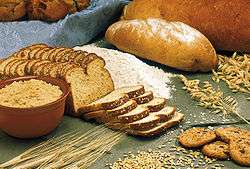Food group
A food group is a collection of foods that share similar nutritional properties or biological classifications. List of nutrition guides typically divide foods into food groups and Recommended Dietary Allowance recommend daily servings of each group for a healthy diet. In the United States for instance, USDA has described food as being in from 4 to 11 different groups.[1]

The most common food groups
- Dairy, also called milk products and sometimes categorized with milk alternatives or meat, is typically a smaller category in nutrition guides,[2][3][4] if present at all, and is sometimes listed apart from other food groups.[2][3] Examples of dairy products include milk, butter, ghee, yogurt, cheese, cream and ice cream. The categorization of dairy as a food group with recommended daily servings has been criticized by, for example, the Harvard School of Public Health who point out that "research has shown little benefit, and considerable potential for harm, of such high dairy intakes. Moderate consumption of milk or other dairy products—one to two servings a day—is fine, and likely has some benefits for children. But it’s not essential for adults, for a host of reasons."[5]
- Fruits, sometimes categorized with vegetables, include apples, oranges, bananas, berries and lemons. Fruits contain carbohydrates, mostly in the form of sugar as well as important vitamins and minerals.
- Grains, beans and legumes, sometimes categorized as cereals, is often the largest category in nutrition guides.[2][3][4] Examples include wheat, rice, oats, barley, bread and pasta. An example of beans would be baked beans and soy beans, while an example of legumes would be lentils and chickpeas. Grains are a good source of starch and are often categorized with other starchy food such as potatoes.
- Meat, sometimes labelled protein and occasionally inclusive of legumes and beans, eggs, meat analogues and/or dairy, is typically a medium- to smaller-sized category in nutrition guides.[2][3][4] Examples include chicken, fish, turkey, pork and beef.
- Confections, also called sugary foods and sometimes categorized with fats and oils, is typically a very small category in nutrition guides, if present at all, and is sometimes listed apart from other food groups.[2][3] Examples include candy, soft drinks, and chocolate.
- Vegetables, sometimes categorized with fruit and occasionally inclusive of legumes, is typically a large category second only to grains, or sometimes equal or superior to grains, in nutrition guides.[2][3][4] Examples include spinach, carrots, onions, and broccoli.
- Water is treated in very different ways by different food guides. Some exclude the category,[4] others list it separately from other food groups,[2] and yet others make it the center[6] or foundation[7] of the guide. Water is sometimes categorized with tea, fruit juice, vegetable juice and even soup,[8] and is typically recommended in plentiful amounts.
Uncommon food groups
The number of "common" food groups varies depending on who is defining them. Canada's Food Guide, which has been in continual publication since 1942 and is the second most requested government document after the income tax form in Canada, recognizes only four official food groups, listing the remainder of foods as "another". Some of these "others" include: Alcoholic beverage or Alcohol is listed apart from other food groups and recommended only for certain people in moderation by Harvard's Healthy Eating Pyramid and the University of Michigan's Healing Foods Pyramid,[9][7] while Italy's food pyramid includes a half-serving of wine and beer.[10]
See also
References
- Nestle, Marion (2013) [2002]. Food Politics: How the Food Industry Influences Nutrition and Health. University of California Press. pp. 36–37. ISBN 978-0-520-27596-6.
- "The Australian Guide to Healthy Eating - Enjoy a Variety of Foods Every Day". Australian Government Department of Health and Ageing. Archived from the original on March 19, 2011. Retrieved 3 June 2011.
- "The eatwell plate". National Health Service. Retrieved 3 June 2011.
- "USDA's MyPlate". United States Department of Agriculture. Retrieved 2 June 2011.
- "Healthy Eating Plate & Healthy Eating Pyramid". 18 September 2012.
- "Eine runde Sache: Der neue DGE-Ernährungskreis". Deutsche Gesellschaft für Ernährung (in German). Retrieved 11 June 2011.
- "Healing Foods Pyramid™ 2010". University of Michigan Health System. Archived from the original on 5 June 2011. Retrieved 3 June 2011.
- "Recommendations for healthy, tasty eating and drinking for adults" (PDF). Swiss Society for Nutrition. Archived from the original (PDF) on 2 November 2011. Retrieved 12 June 2011.
- "Healthy Eating Pyramid". Harvard School of Public Health. Retrieved 23 August 2016.
- "Piramide Alimentare Italiana". Istituto di Scienza dell'Alimentazione (in Italian). Università di Roma. Retrieved 11 June 2011.